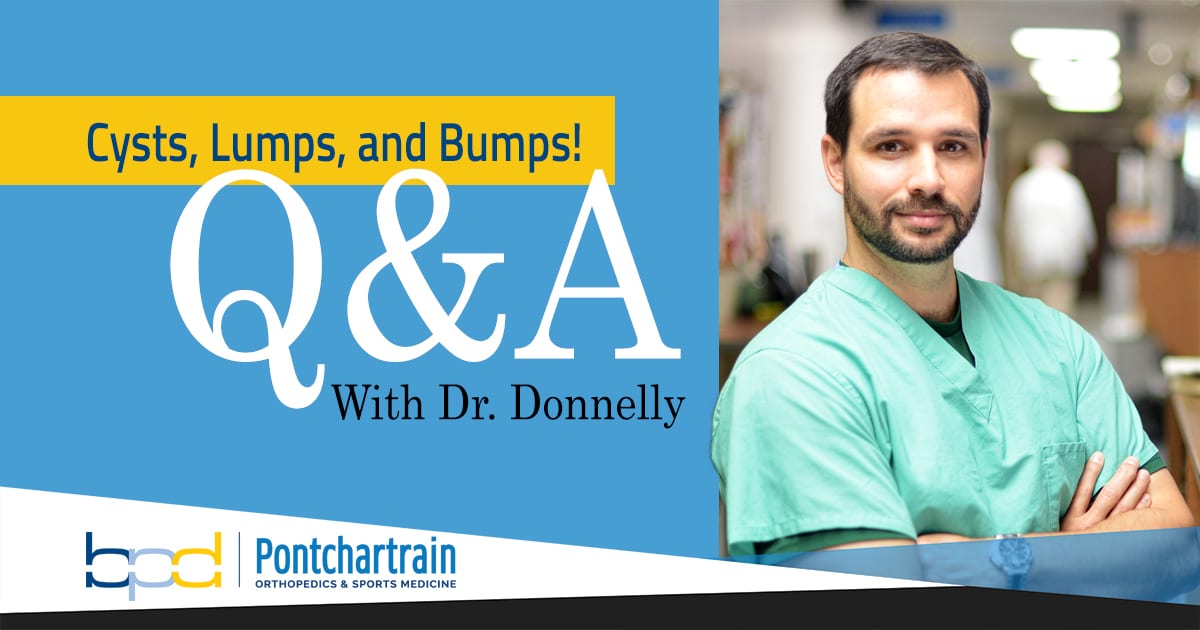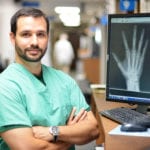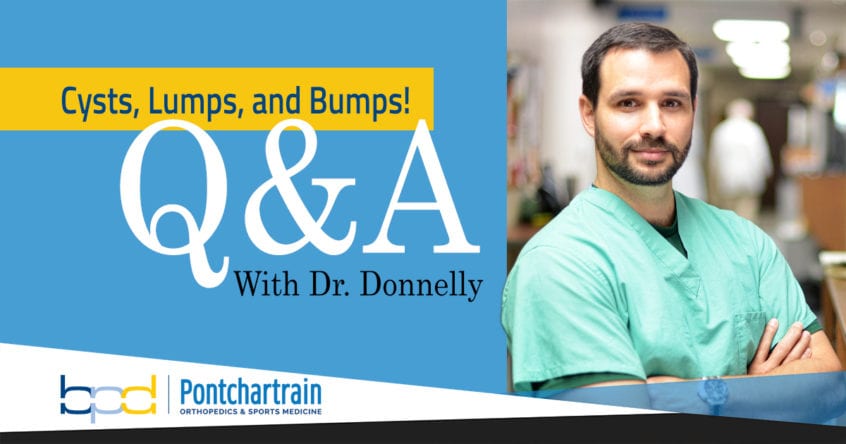
Encountering unfamiliar cysts, lumps and bumps on our hands, arms or elbows can be stressful. Are they malignant? Should I be worried? Will they go away on their own?
The good news, according to Dr. Donnelly is, most cysts, lumps and bumps are easy to spot, common and generally harmless.
“Fortunately, malignant tumors and masses in the hands are very uncommon – other than skin cancers,” Donnelly says. “Sometimes you’ll have one and they’re rapidly growing and painful. So, those are the buzzwords I use: rapidly growing, overlying skin changes, could be painful – that’s where you want to get those checked out.”
In today’s blog post Dr. Donnelly discusses the characteristics and causes of a wide range of cysts, lumps and bumps you may find on your hands, wrists, and elbows, as well as various treatment options.
Ganglion and Retinacular Cysts - What’s the Difference?
For the most part, the difference between ganglion and retinacular cysts is where they are located. The ganglion cyst typically arises from a joint, whereas the retinacular cyst sits on a sheath, most often on the tendon. They’re usually small. A ganglion cyst, particularly the ones on the wrist, can get to the size of a grape. Usually, they’re more the size of chickpea. Retinacular cysts are usually about the size of a BB, or a very small green pea. They’re both fluid filled, with a gelatinous type of tissue.

What causes ganglion and retinacular cysts?


Are ganglion and retinacular cysts treated differently?

"I have a ganglion cyst, and it doesn’t bother me. I show it to all of my patients with cysts."
Ganglion cysts can be painful, particularly during an extension of the wrist – meaning push-up activities, or yoga. In those instances, you can choose to aspirate it, or suck out the fluid, and put a little steroid in there, or you would do surgery to excise it.
The retinacular cysts, on the other hand, are more symptomatic – because they are right in the area where we are trying to grip something. They’re point tender. Oftentimes, they’re at risk of rupture, so I’ll inject them with a little numbing medicine then we’ll pop it, like popping a balloon.
What are Soft Tissue Masses?
Soft tissue masses are cell growths that can develop nearly anywhere on the body. As the name implies, soft tissues like blood vessels, cartilage, fat, ligaments, muscles, nerves, tendons, and other tissues can develop masses. When we talk about cysts, lumps, and bumps, soft tissues masses are typically the lumps and bumps.

What are giant-cell tumors?

The giant-cell tumor of the tendon sheath is probably the most common soft tissue mass we see. It’s a benign accumulation of what we call “giant cells,” a particular type of cell that forms into a tumor. It’s not related to trauma, or anything like that. Like a lot of cysts, lumps, and bumps, they just happen; there’s no definitive cause for it.
Giant cell tumors are most often found along the palm side of the fingers. they are usually slow growing. They are not usually painful, and oftentimes arise from the joint. The treatment for that is a surgical excision. But they have a chance for recurrence.

What are lipomas?


Do skin cancers cause cysts, lumps, and bumps?

Other types of cysts, lumps, and bumps

What are epidermal inclusion cysts?


What is a glomus tumor?


What is a Dupuytren nodule?


What is a carpal boss?


What is olecranon bursitis?

When examining cysts, lumps, and bumps on the elbow, we might see olecranon bursitis. That’s a variable-sized bump that we get on the backside of the elbow, right over the tip of the elbow. It can be associated with a mild trauma, or repetitive leaning on the elbow. I see it commonly with truck drivers, and mechanics who are working underneath the car and have to use their elbows to shimmy themselves around.
More often than not, it’s just a fluid-filled sac that develops from the irritation in that area. With the right conservative measures, you can find relief with a compression wrap or an elbow pad. The biggest thing is to avoid that repetitive trauma. Sometimes, we’ll drain the fluid with a needle. Infrequently, it gets infected and becomes big, red and swollen. Sometimes, we can just drain it and treat it with antibiotics. Other times, we need to do a surgical excision.
Have a Curious Cyst, Lump, or Bump?
Most skin lumps and bumps in the upper extremity are harmless, and won’t change into cancer. However, if you have a lump, bump or cyst that’s become painful, begun to grow or change appearance rapidly or caused changes in the skin, call Dr. Brandon P. Donnelly today to schedule an evaluation.
About Dr. Brandon P. Donnelly, MD
 Dr. Brandon P. Donnelly is a board certified orthopedic surgeon with Pontchartrain Orthopedics & Sports Medicine. Dr. Donnelly completed his hand and microsurgery fellowship at the prestigious Philadelphia Hand to Shoulder Center. Dr. Donnelly treats all ages of patients in the greater New Orleans area for hand, wrist, and elbow conditions.
Dr. Brandon P. Donnelly is a board certified orthopedic surgeon with Pontchartrain Orthopedics & Sports Medicine. Dr. Donnelly completed his hand and microsurgery fellowship at the prestigious Philadelphia Hand to Shoulder Center. Dr. Donnelly treats all ages of patients in the greater New Orleans area for hand, wrist, and elbow conditions.
This site is not intended to and does not provide medical advice, professional diagnosis, opinion, treatment or services to you or to any other individual. Through this website and links to other websites, Brandon P. Donnelly, MD provides general information for educational purposes only. The content provided in this website and links, is not a substitute for medical care or treatment. You should not use this information in place of a consultation or the advice of your healthcare provider. Brandon P. Donnelly, MD is not liable or responsible for any advice, course of treatment, diagnosis or any other information, services or product you obtain through this site.

